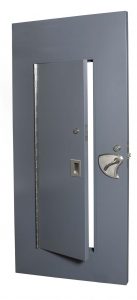Minimizing Safety and Security Risks in Behavioral Healthcare Facilities
Providing an environment that focuses on hope, healing, and recovery, while reducing risk of self-harm, or loss of life, is the goal of behavioral health facilities. Strict, updated policies, adopted to assure the safety and dignity of patients, while also providing security for staff members, are currently being stringently enforced by the Joint Commission (TJC) and the Centers for Medicare & Medicaid Services (CMS).
Due to the alarming increase in suicides in behavioral healthcare environments, hospitals must take immediate action to minimize or eliminate safety and security risks in their physical environments. And, as every hospital and behavioral health center already knows, CMS reimbursement hinges upon compliance with the stringent regulations.
According to Denise Haberkorn, ASSA ABLOY Healthcare Specialist, “…there has been no bigger challenge for healthcare facilities than the new survey criteria rolled out in 2017…”
ASSA ABLOY, a global leader in door opening solutions, is a prominent provider of “high-risk-approved” behavioral health door hardware, developed in response to the code updates in NFPA 101 2012 and NFPA 99 2012, Chapter 4, which went into effect July 1, 2017. As a result, beginning January 1, 2017, the Joint Commission made significant changes in its survey methods and its Standards Manual, addressing the “environment of care” (EOC).
The EOC is made up of the following three basic elements:
- The building or space, including how it is arranged
- Special features that protect patients, visitors, and staff
- Equipment used to support patient care, or to safely operate the building or space

Denise Haberkorn
Denise Haberkorn, a Healthcare Specialist with ASSA ABLOY Door Security Solutions in the Greater Chicago Area, said, “I have been working in the healthcare vertical market for 14 years, there has been no bigger challenge for healthcare facilities than the new survey criteria rolled out in 2017. Particularly the time frame of which some facilities have needed to react to the updates as mandated. I have been in a unique position of having a vast amount of healthcare and industry experience combined with the Behavioral Health product offering from ASSA ABLOY in my back pocket. This has enabled me to consult and assist many facilities with their decision-making process.”
Haberkorn met with Anderson Lock’s Hardware Sales Manager, Jim Walsh, prior to a major renovation of the behavioral health units at University of Illinois Chicago Hospital and Health System. She introduced ASSA ABLOY’s new suite of behavioral health products, and after consultation and specification, Anderson Lock was contracted to supply the healthcare facility with 35 Curries Patient Room Access Doors, and 34 additional Curries’ steel doors.

Patient Room Access Door
The doors were hung on full-surface Pemko hinges with hospital tips, and locked with Corbin ML 2000 mortise locks with anti-ligature BHSS trim. BHSS’s unique, integrated lever and escutcheon design, delivers ease of operation, along with the strength and versatility of the traditional ML 2000 lock—all while meeting the anti-ligature needs of the unit.
Existing hospital rooms often have tight-fitting doors that swing into patient rooms. However, in-swinging doors have the potential to be barricaded by patients to keep staff from entering the rooms. One solution to barricading is the Curries ‘Patient Room Access Doors’ which have been designed with special behavioral health features. They are similar to a ‘wicket’ or ‘door-within-a-door.’
Anderson Lock has recently provided similar solutions for many other facilities. Our security professionals are knowledgeable about current codes and risk assessments. Our excellent vendor relationships give us the ability to quickly source ASSA ABLOY’s suite of behavioral health hardware products when required to meet a TJC or CMS inspection. And our experience helps us specify to the level of protection required by the occupancy.
Because behavioral health facilities admit patients who are already at a crisis point in their lives, it is imperative that ligature points, and barricade scenarios, which may result in loss of life, are eliminated.



